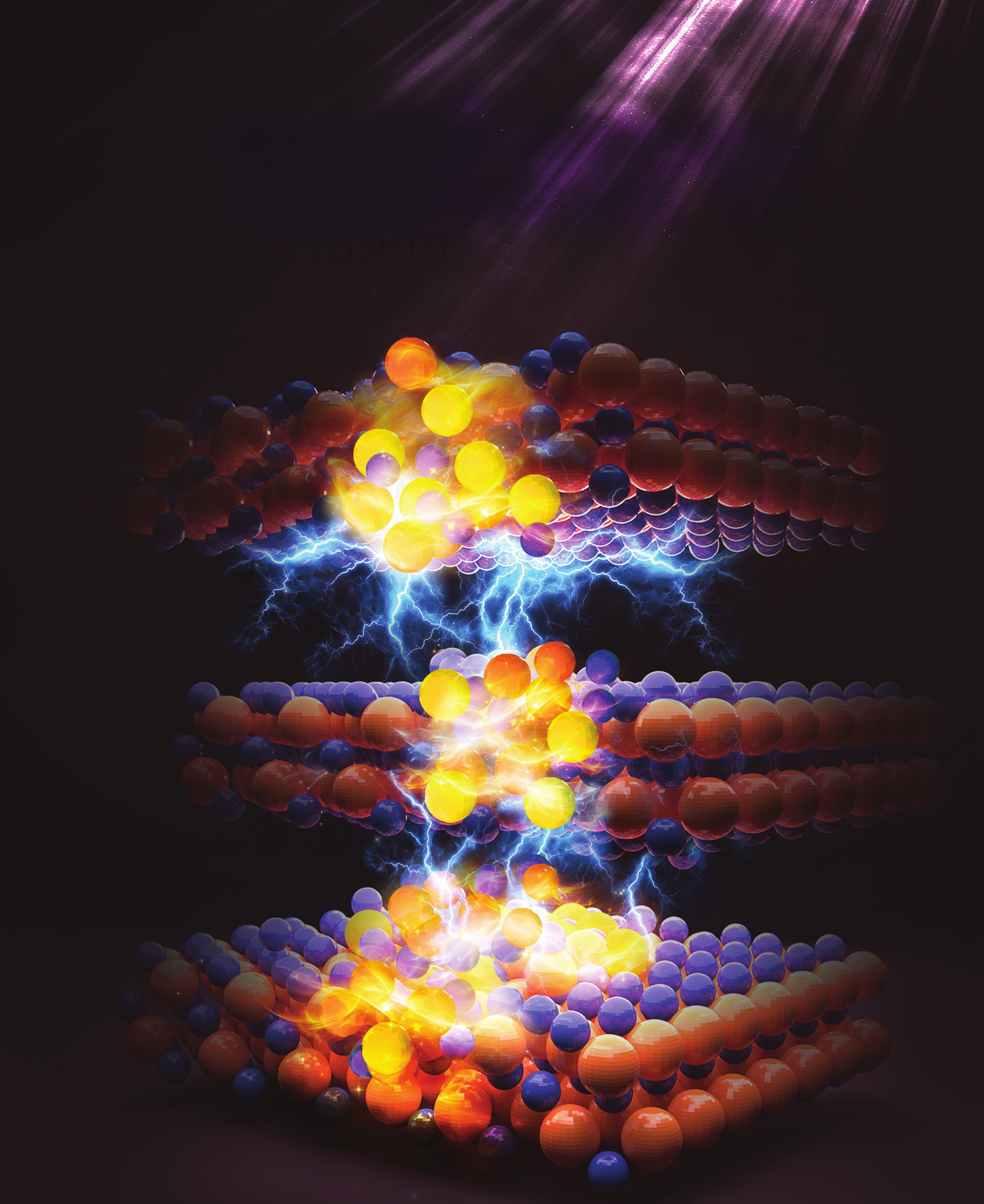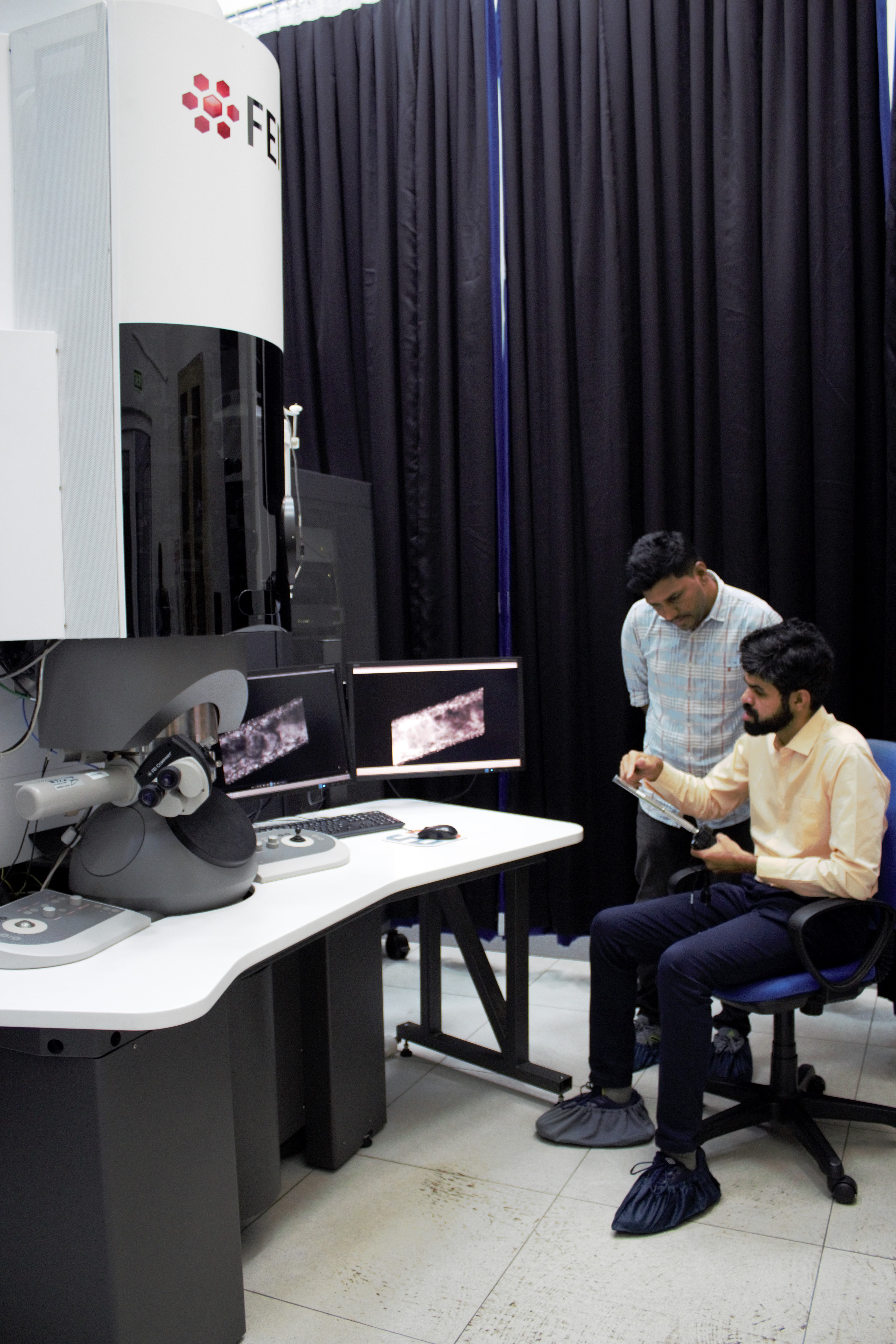06 November 2024
In breakthrough collaborative work published today in Nature, researchers show that a material called indium selenide can “shock” itself to transform from a crystalline to glassy phase using very low power. This transformation lies at the heart of memory storage in devices like CDs and computer RAMs. It consumes a billion times less power than the traditional melt-quench process used to convert crystal to glass.
The team includes researchers from the Indian Institute of Science (IISc), University of Pennsylvania School of Engineering and Applied Science (Penn Engineering), and Massachusetts Institute of Technology (MIT).

Artist’s impression of electrically driven amorphisation in indium selenide, a layered semiconducting ferroelectric material. The middle layer is slipped by the carrier-wind force, and the lightning bolts indicate electrical spikes from piezoelectricity-induced mechanical shocks, which amorphise the material (Image: Akanksha Jain)
Glasses behave like solids but lack the typical periodic arrangement of atoms. During glassmaking, a crystal is liquefied (melted) and then suddenly cooled (quenched) to prevent the glass from becoming too organised. This melt-quench process is also used in CDs, DVDs and Blu-ray discs – laser pulses are used to heat and quench a crystalline material to the glassy phase very quickly in order to write data; reversing the process can erase data. Computers use similar materials called phase-change RAMs, in which information is stored based on the type of resistance – high versus low – offered by the glassy and crystalline states.
The problem, however, is that these devices are very power hungry, especially during the writing process. The crystals need to be heated to temperatures exceeding 800oC and suddenly cooled. If there is a way to convert the crystal directly to glass without the intermediate liquid phase, the power required for memory storage can significantly be reduced.
In the study, the team discovered that when electric current was passed through wires made of indium selenide, a 2D ferroelectric material, long stretches of the material suddenly amorphised into glass. “This was extremely unusual,” says Gaurav Modi, former PhD student at Penn Engineering and one of the first authors. “I actually thought that I might have damaged the material. Normally, you would need electrical pulses to induce any kind of amorphisation, and here, a continuous current had disrupted the crystalline structure, which shouldn’t have happened.”
Modi and Ritesh Agrawal, Srinivasa Ramanujan Distinguished Scholar in Materials Science and Engineering (MSE) at Penn Engineering, worked with Pavan Nukala, Assistant Professor at the Centre for Nano Science and Engineering (CeNSE), IISc and his PhD student Shubham Parate to closely track this process – from atomic to micrometre length scales – under an electron microscope.
“Over the past few years, we have developed a suite of in situ microscopy tools here at IISc,” Nukala explains. “When Ritesh told me about this unusual observation, we decided that it was time to put these tools to the test.”

Pavan Nukala (right) with Pradeep Kumar (left), in-charge of electron microscope facility at CeNSE. Images of biased nanowires are projected on the screen (Photo: Manjunath NS)
What the team found was that when a continuous current is passed parallel to the material’s 2D layers, the layers slide against each other in different directions. This causes the formation of many domains – tiny pockets with a specific dipole moment – bound by defective regions that separate the domains. When multiple defects intersect in a small nanoscopic region, like too many holes punched in a wall, the structural integrity of the crystal collapses to form glass locally.
These domain boundaries are like tectonic plates. They move with the electric field, and when they collide against each other, mechanical (and electrical) shocks are generated akin to an earthquake. This earthquake triggers an avalanche effect, causing disturbances far away from the epicentre, creating more domain boundaries and resulting glassy regions, which in turn spawns more earthquakes. The avalanche stops when the entire material turns into glass (long-range amorphisation).
“It’s just goosebumps stuff to see all of these factors come to life and play together, at different length scales in an electron microscope,” says Parate, one of the first authors.
Nukala points out that multiple unique properties of indium selenide – its 2D structure, ferroelectricity and piezoelectricity – all come together to allow this ultralow energy pathway for amorphisation through shocks. “We are going to push this to the next level to integrate these devices on CMOS platforms,” he adds.
“One of the reasons why phase-change memory (PCM) devices haven’t reached widespread use is due to the energy required,” says Agarwal. Such an advancement could unlock a wider range of PCM applications that could transform data storage in devices, from cell phones to computers.
REFERENCE:
Modi G, Parate SK, Kwon C, Meng AC, Khandelwal U, Tullibulli A, Horwath J, Davies PK, Stach EA, Li J, Nukala P, Agarwal R, Electrically-driven long-range solid-state amorphization in ferroic In2Se3, Nature (2024).
https://www.nature.com/articles/s41586-024-08156-8
CONTACT:
Pavan Nukala
Assistant Professor
Centre for Nano Science and Engineering (CeNSE)
Indian Institute of Science (IISc)
Email:
pnukala@iisc.ac.in
Ritesh Agarwal
Professor & Srinivasa Ramanujan Distinguished Scholar
Materials Science and Engineering
University of Pennsylvania
Phone: (215) 573-3037
NOTE TO JOURNALISTS:
a) If any of the text in this release is reproduced verbatim, please credit the IISc press release.
b) For any queries about IISc press releases, please write to
news@iisc.ac.in or
pro@iisc.ac.in.



